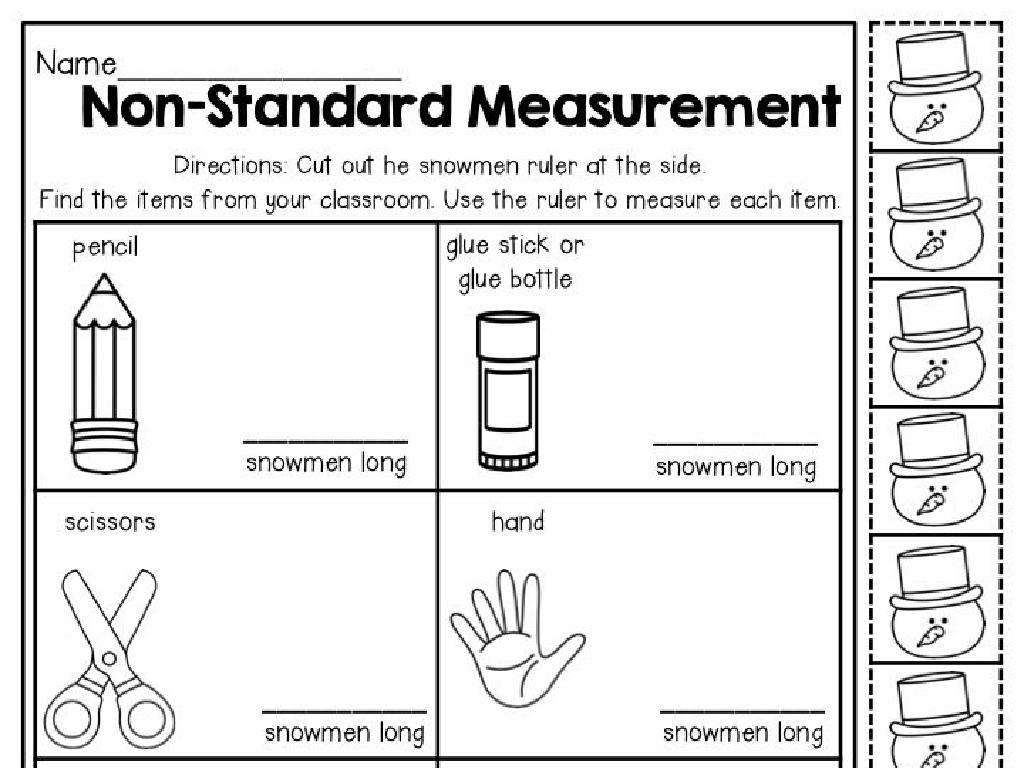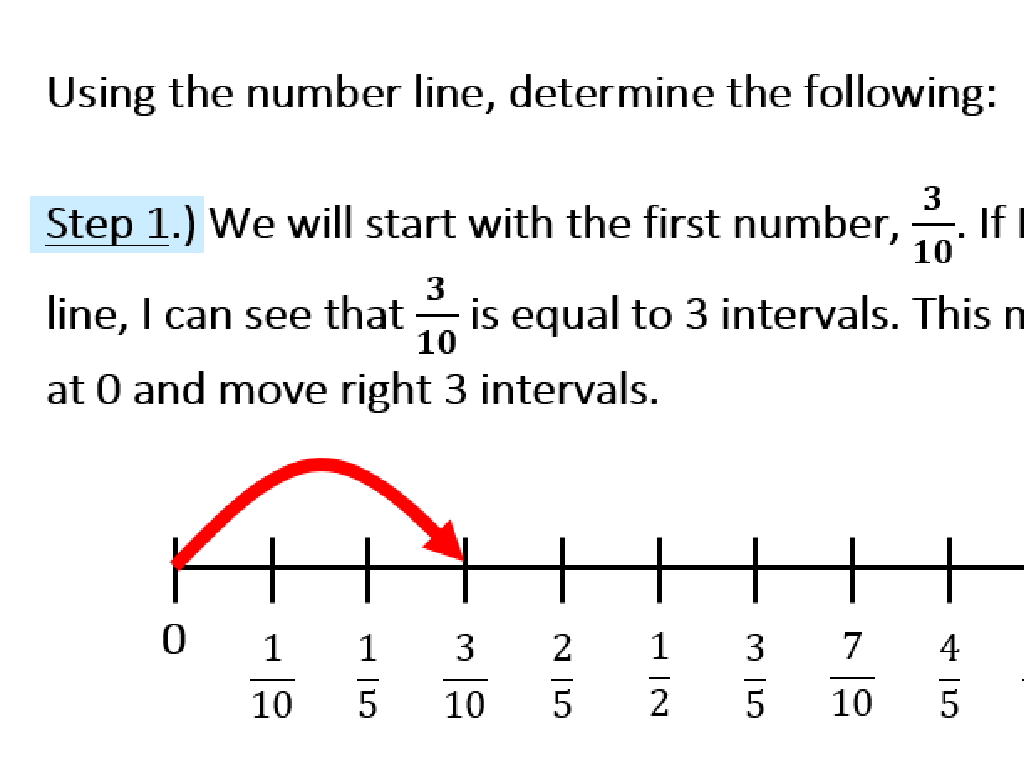Interpret Line Plots
Subject: Math
Grade: Second grade
Topic: Data And Graphs
Please LOG IN to download the presentation. Access is available to registered users only.
View More Content
Interpreting Line Plots
– Learn to read line plots
– Discover data on graphs
– A line plot shows data along a number line
– Discuss importance of graphs
– Graphs help us organize and understand numbers
– Engage with fun graph activities
– We’ll use candies or stickers for our graph!
|
This slide introduces second graders to the concept of line plots, a type of graph that displays data along a number line. Start by explaining what a line plot is and show a simple example, like tracking daily temperatures. Emphasize the importance of graphs in making information easy to see and understand. Ask the students why they think graphs might be useful, prompting them to think about their use in everyday life. Plan a hands-on activity where students can create their own line plots using classroom objects like candies or stickers to represent data points. This will help them grasp the concept of data representation on a line plot in a fun and interactive way.
Understanding Line Plots
– What is a line plot?
– A graph using a number line to show data
– ‘X’ marks the data spot
– Each X is a different piece of data, like a favorite fruit
– Example: Our class’s shoe sizes
– We’ll use X’s to show how many have each shoe size
– Counting X’s to find totals
– Add up the X’s to see which size is most common
|
This slide introduces the concept of line plots to second-grade students. Begin by explaining that a line plot is a simple graph that displays data along a number line. Each ‘X’ on the plot represents one piece of data. Use an example that is relevant and easy to understand, such as the shoe sizes of students in the class. Show how each student’s shoe size is marked on the number line with an ‘X’. Then, demonstrate how to count the number of ‘X’s above each number to find out how many students have that shoe size. This will help students understand how to interpret data from a line plot. Encourage students to ask questions and to come up with their own examples of data that could be displayed on a line plot.
Creating a Line Plot
– Start with a number line
– A straight line to represent numbers in order
– Mark equal spaces for numbers
– Each space stands for one unit on the scale
– Plot data with Xs above numbers
– Each X represents one piece of data on our plot
|
This slide introduces students to the basics of creating a line plot, which is a type of graph useful for showing frequency of data. Begin by drawing a horizontal line, which will serve as the number line. It’s important to space the numbers equally to ensure accuracy. Then, students will learn to represent data by placing Xs above the corresponding numbers on the line plot. This visual representation helps them to easily see how often each data point occurs. Encourage students to practice by creating their own line plots with classroom data, such as favorite fruits or shoe sizes.
Reading a Line Plot
– Understand what a line plot is
– Count the Xs above each number
– The Xs show how often a number comes up
– Each X represents one occurrence
– Practice counting Xs together
– Let’s count the Xs as a group activity
|
This slide is aimed at teaching second-grade students how to read a line plot. Begin by explaining that a line plot is a way to display data visually. Show them that each X above a number on the line plot represents one instance of that number appearing in the data set. Encourage the students to count the Xs to determine the frequency of each number. Make this an interactive class activity by counting the Xs together. This will help students understand how to interpret data from a line plot. Provide a simple line plot as an example and guide them through the process of counting and interpreting the Xs.
Interpreting Data from Line Plots
– Understanding our line plot
– What does the data show?
– Look for patterns or trends in the Xs
– Finding the number with most Xs
– The number with the most Xs is the most common
– Discussing our observations
– Share what you think the data means
|
This slide is aimed at helping second-grade students understand how to interpret data from a line plot. Start by reviewing the line plot created by the class. Ask the students what they notice about the distribution of Xs along the number line. Guide them to see which number has the most Xs and discuss what that means – for example, if it’s a plot of favorite fruits, the fruit with the most Xs might be the class favorite. Encourage the students to think about why that number has the most Xs and what information this gives us about the data collected. Finish by asking the students to share their own interpretations of the data.
Comparing Data with Line Plots
– Line plots can show data
– Compare two line plots
– Look at two plots and find what’s different or the same
– Notice differences and similarities
– Check the number of data points, range, and intervals
– Let’s practice comparing!
|
This slide introduces the concept of comparing data using line plots. Students will learn that line plots are a visual representation of data and can be used to compare different sets of information. When comparing two line plots, students should look for differences and similarities in the number of data points, the range of the data, and the intervals between data points. Encourage students to observe carefully and discuss their observations. For the activity, present two simple line plots and guide the students to compare them by asking questions like ‘Which plot has more data points?’ or ‘What is the range of each plot?’ This will help them understand how to interpret and compare data visually.
Practice Time: Create Your Own Line Plot!
– It’s time to make a line plot
– Use the provided data
– I’ll give you a list of numbers to plot
– Place your Xs with precision
– Each X marks a data point on the plot
– Review what each X represents
– Remember, each X stands for an item or number in our data
|
This slide is designed to engage students in an interactive activity where they will apply their knowledge of line plots. Provide each student with a set of data, which could be anything from the number of apples of different colors, the heights of classmates, or the number of pets each student has. Remind them to carefully place an X above the corresponding number on the horizontal axis for each data point they have. This exercise will help solidify their understanding of how to represent data visually using a line plot. Encourage them to double-check their plots for accuracy. For the teacher: Prepare four to five different sets of data to cater to the varying levels of students in the class. This will ensure that all students are challenged appropriately and can successfully create a line plot.
Line Plot Scavenger Hunt Activity
– Let’s have a scavenger hunt!
– Find and count classroom objects
– Create a line plot with your counts
– Use a number line and X’s to show counts
– Share and explain your line plot
– Tell us what your data shows about our classroom
|
This interactive class activity is designed to help second-grade students understand and create line plots. Begin by explaining what a line plot is: a simple graph that shows frequency of data along a number line. Then, organize a scavenger hunt where students search for various objects around the classroom. Once they’ve collected their data, guide them in representing their findings on a line plot, using X’s to mark the frequency of each item found. Encourage creativity and ensure they understand that each X represents one object found. After creating their line plots, students will present their findings to the class, explaining what their data reveals about the objects in the classroom. This activity not only reinforces the concept of line plots but also fosters public speaking and data interpretation skills.






